高中16种英语时态总结归纳PDF
- 格式:pdf
- 大小:219.21 KB
- 文档页数:6

时态(Tense)是表示行为、动作和状态在各种时间条件下的动词形式。
因此,当我们说时态结构的时候,指的是相应时态下的动词形式。
英语时态分为16种:一般现在、一般过去、一般将来、过去将来时,以及这四者的进行时、完成时和完成进行时。
下面是16种时态的谓语动词形式和具体用法,高考必考的是前十个时态,同学们需要重点掌握。
1.一般现在时(do/does; is/am/are)①表示现在的情况、状态或特征。
例:He is a student.他是一个学生。
②表示经常性、习惯性动作。
例:He always helps others.他总是帮助别人。
③客观事实和普遍真理。
例:The earth moves the sun.地球绕着太阳转。
④表示一个按规定、计划或安排要发生的动作。
仅限于某些表示“来、去、动、停、开始、结束、继续”等的动词,可以与表示未来时间的状语搭配使用。
常见的用法是:飞机、火车、轮船、汽车等定期定点运行的交通方式。
例:The next train leaves at 3 o'clock this afternoon.下一趟火车今天下午3点开车。
⑤在时间、条件和让步状语从句中经常用一般现在(有时也用现在完成时)表示将的来事情。
(即:主将从现原则)例:I will call you as soon as I arrive at the airport.我一到机场就会给你打电话。
When you have finished the report, I will have waited for about 3 hours.等你完成这份报告的时候,我就已经等了将近3个小时了。
2. 现在进行时(am/is/are doing)①表示此时此刻正在发生的事情。
例:He is listening to the music now.他现在正在听音乐。
②表示目前一段时间内一直在做的事情,但不一定此时此刻正在做。
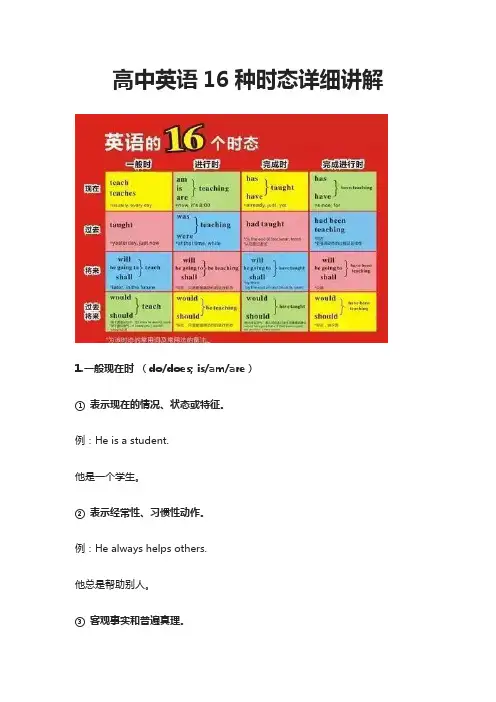
高中英语16种时态详细讲解1.一般现在时(do/does; is/am/are)①表示现在的情况、状态或特征。
例:He is a student.他是一个学生。
②表示经常性、习惯性动作。
例:He always helps others.他总是帮助别人。
③客观事实和普遍真理。
例:The earth moves the sun.地球绕着太阳转。
④表示一个按规定、计划或安排要发生的动作。
仅限于某些表示“来、去、动、停、开始、结束、继续”等的动词,可以与表示未来时间的状语搭配使用。
常见的用法是:飞机、火车、轮船、汽车等定期定点运行的交通方式。
例:The next train leaves at 3 o'clock this afternoon.下一趟火车今天下午3点开车。
⑤在时间、条件和让步状语从句中经常用一般现在(有时也用现在完成时)表示将的来事情。
(即:主将从现原则)例:I will call you as soon as I arrive at the airport.我一到机场就会给你打电话。
When you have finished the report, I will have waited for about 3 hours. 等你完成这份报告的时候,我就已经等了将近3个小时了。
2. 现在进行时(am/is/are doing)①表示此时此刻正在发生的事情。
例:He is listning to the music now.他现在正在听音乐。
②表示目前一段时间内一直在做的事情,但不一定此时此刻正在做。
例:I am studying computer this term.这个学期我一直在学习计算机。
③现在进行时可以表示将来的含义。
a. 瞬时动词的进行一定表将来。
例:I am leaving.我要离开了。
b. 持续动词的进行只有有将来的时间状语或有将来语境中才表将来。
例:I am travelling next month.下个月我要去旅行。
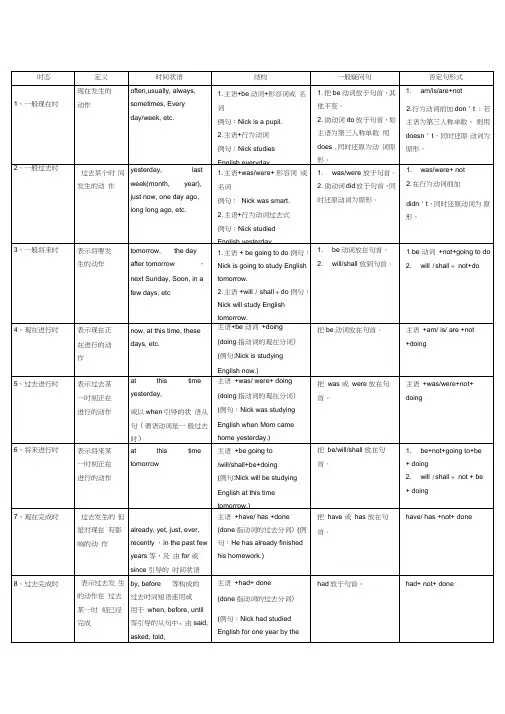
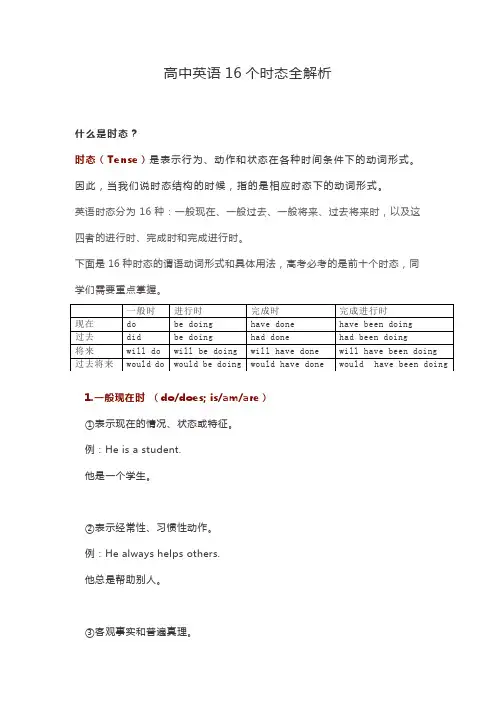
1.一般现在时(do/does; is/am/are)①表示现在的情况、状态或特征。
例:He is a student.他是一个学生。
②表示经常性、习惯性动作。
例:He always helps others.他总是帮助别人。
③客观事实和普遍真理。
例:The earth moves the sun.地球绕着太阳转。
④表示一个按规定、计划或安排要发生的动作。
仅限于某些表示“来、去、动、停、开始、结束、继续”等的动词,可以与表示未来时间的状语搭配使用。
常见的用法是:飞机、火车、轮船、汽车等定期定点运行的交通方式。
例:The next train leaves at 3 o'clock this afternoon.下一趟火车今天下午3点开车。
⑤在时间、条件和让步状语从句中经常用一般现在(有时也用现在完成时)表示将的来事情。
(即:主将从现原则)例:I will call you as soon as I arrive at the airport.我一到机场就会给你打电话。
When you have finished the report, I will have waited for about 3 hours.等你完成这份报告的时候,我就已经等了将近3个小时了。
2. 现在进行时(am/is/are doing)①表示此时此刻正在发生的事情。
例:He is listning to the music now.他现在正在听音乐。
②表示目前一段时间内一直在做的事情,但不一定此时此刻正在做。
例:I am studying computer this term.这个学期我一直在学习计算机。
③现在进行时可以表示将来的含义。
瞬时动词的进行一定表将来。
例: I am leaving.我要离开了。
持续动词的进行只有有将来的时间状语或有将来语境中才表将来。
例: I am travelling next month.下个月我要去旅行。
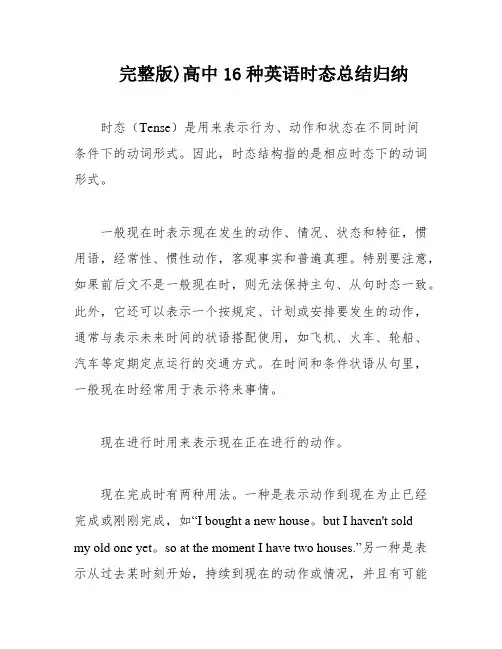
完整版)高中16种英语时态总结归纳时态(Tense)是用来表示行为、动作和状态在不同时间条件下的动词形式。
因此,时态结构指的是相应时态下的动词形式。
一般现在时表示现在发生的动作、情况、状态和特征,惯用语,经常性、惯性动作,客观事实和普遍真理。
特别要注意,如果前后文不是一般现在时,则无法保持主句、从句时态一致。
此外,它还可以表示一个按规定、计划或安排要发生的动作,通常与表示未来时间的状语搭配使用,如飞机、火车、轮船、汽车等定期定点运行的交通方式。
在时间和条件状语从句里,一般现在时经常用于表示将来事情。
现在进行时用来表示现在正在进行的动作。
现在完成时有两种用法。
一种是表示动作到现在为止已经完成或刚刚完成,如“I bought a new house。
but I haven't soldmy old one yet。
so at the moment I have two houses.”另一种是表示从过去某时刻开始,持续到现在的动作或情况,并且有可能会继续延续下去。
这时通常使用延续性动词,时间状语常用since加一个过去的时间点,或for加一段时间,或by加一个现在时间。
4.现在完成进行时 (have been doing)现在完成进行时用来描述一个从过去某一时间开始一直持续到现在的动作或状态,或将继续持续到未来。
例如:我们已经处理这个项目一个多月了,一直在进行中。
5.一般过去时一般过去时用来描述过去某个时间发生的动作或情况,或者过去的惯性动作。
例如:这位老人过去常常坐在公园的长椅上看着别人,一坐就是数个小时。
他以前总是每周看望他的母亲。
在句型中使用 "no sooner than"、"___"、"before"、"r to" 等连接词时,主句要求完成时。
例如:今天之前我从未见过那位教授。
在填空题中,句子中的动作已经持续了一段时间,并且需要进行修理。
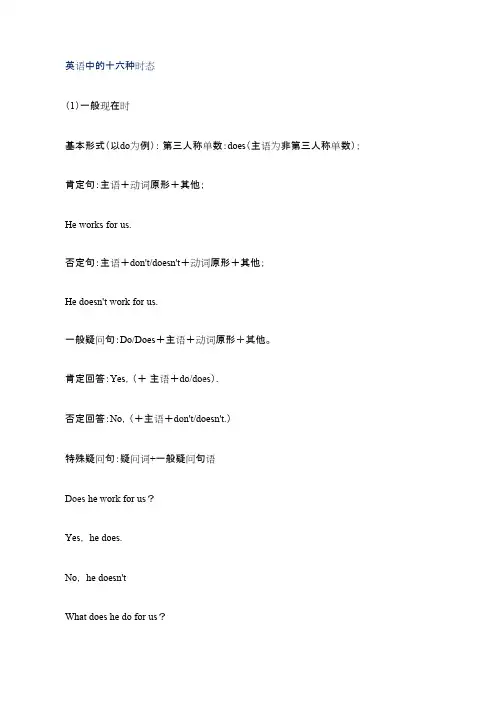
英语中的十六种时态(1)一般现在时基本形式(以do为例):第三人称单数:does(主语为非第三人称单数);肯定句:主语+动词原形+其他;He works for us.否定句:主语+don't/doesn't+动词原形+其他;He doesn't work for us.一般疑问句:Do/Does+主语+动词原形+其他。
肯定回答:Yes,(+主语+do/does).否定回答:No,(+主语+don't/doesn't.)特殊疑问句:疑问词+一般疑问句语Does he work for us?Yes, he does.No, he doesn'tWhat does he do for us?He works for us.(2)一般过去时be动词+行为动词的过去式否定句式:在行为动词前加didn't,同时还原行为动词,或was/were+not;was或were放于句首;用助动词do的过去式did提问,同时还原行为动词例如: Did he work for us?He didn't work for us.He worked for us.(3)一般将来时am/are/is+going to+do 或will/shall+doam/is/are/about to + doam/is/are to + do;一般将来时的表达方法be going to +动词原形be +不定式,be to+动词原形,be about to +动词原形be able to +不定式be about to+动词原形will + 动词原形;例如:He is going to work for us.He will work for us;He is coming.这是特殊的用一般现在时表达将来时态的例子!!(4)过去将来时be(was,were)going to+动词原形be(was,were)about to+动词原形be(was,were)to+动词原形肯定句:主语+be(was,were)going to+动词原形~.否定句:主语+be(was,were)not going to+动词原形~.疑问句:Be(Was,Were)+主语+going to+动词原形~?肯定句:主语+would(should)+动词原形~.否定句:主语+would(should)not+动词原形~.疑问句:Would(Should)+主语+动词原形~?He would work for us.(5)现在进行时主语+be+v.ing〔现在分词〕形式(其中v表示动词)表示现在正在进行的动作或最近在做的事。

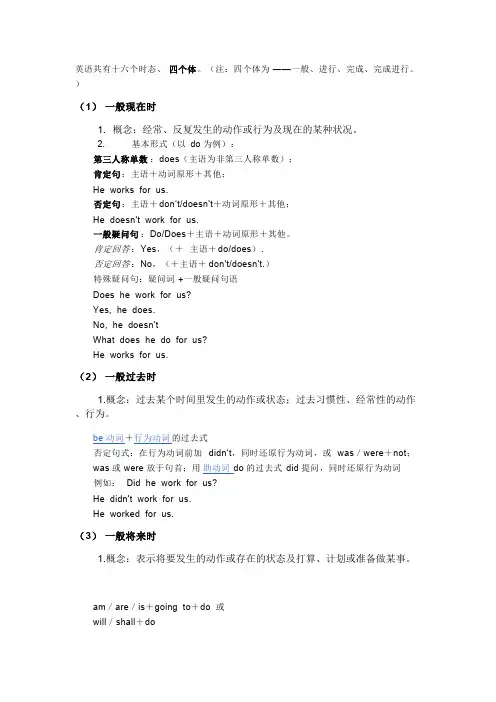
英语共有十六个时态、四个体。
(注:四个体为——一般、进行、完成、完成进行。
)(1)一般现在时1.概念:经常、反复发生的动作或行为及现在的某种状况。
2. 基本形式(以do为例): 第三人称单数:does(主语为非第三人称单数); 肯定句:主语+动词原形+其他; He works for us. 否定句:主语+don‘t/doesn't+动词原形+其他; He doesn't work for us. 一般疑问句:Do/Does+主语+动词原形+其他。
肯定回答:Yes,(+主语+do/does). 否定回答:No,(+主语+don't/doesn't.) 特殊疑问句:疑问词+一般疑问句语 Does he work for us? Yes, he does. No, he doesn't What does he do for us? He works for us.(2)一般过去时1.概念:过去某个时间里发生的动作或状态;过去习惯性、经常性的动作、行为。
be动词+行为动词的过去式 否定句式:在行为动词前加didn‘t,同时还原行为动词,或was/were+not; was或were放于句首;用助动词do的过去式did提问,同时还原行为动词 例如:Did he work for us? He didn't work for us. He worked for us.(3)一般将来时1.概念:表示将要发生的动作或存在的状态及打算、计划或准备做某事。
am/are/is+going to+do 或 will/shall+do am/is/are/about to + do am/is/are to + do; 一般将来时的表达方法 be going to +动词原形 be +不定式,be to+动词原形,be about to +动词原形 be able to +不定式 be about to+动词原形 will + 动词原形; 例如:He is going to work for us. He will work for us; He is coming.这是特殊的用一般现在时表达将来时态的例子!!(4)过去将来时概念:立足于过去某一时刻,从过去看将来,常用于宾语从句中。
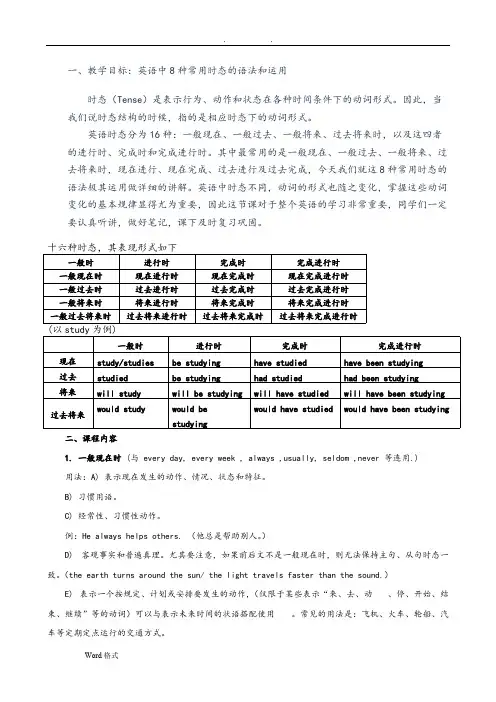
一、教学目标:英语中8种常用时态的语法和运用时态(Tense)是表示行为、动作和状态在各种时间条件下的动词形式。
因此,当我们说时态结构的时候,指的是相应时态下的动词形式。
英语时态分为16种:一般现在、一般过去、一般将来、过去将来时,以及这四者的进行时、完成时和完成进行时。
其中最常用的是一般现在、一般过去、一般将来、过去将来时,现在进行、现在完成、过去进行及过去完成,今天我们就这8种常用时态的语法极其运用做详细的讲解。
英语中时态不同,动词的形式也随之变化,掌握这些动词变化的基本规律显得尤为重要,因此这节课对于整个英语的学习非常重要,同学们一定要认真听讲,做好笔记,课下及时复习巩固。
十六种时态,其表现形式如下一般时进行时完成时完成进行时一般现在时现在进行时现在完成时现在完成进行时一般过去时过去进行时过去完成时过去完成进行时一般将来时将来进行时将来完成时将来完成进行时一般过去将来时过去将来进行时过去将来完成时过去将来完成进行时(以study为例)一般时进行时完成时完成进行时现在study/studies be studying have studied have been studying 过去studied be studying had studied had been studying将来will study will be studying will have studied will have been studying过去将来would study would bestudyingwould have studied would have been studying 二、课程内容 1. 一般现在时 (与 every day, every week , always ,usually, seldom ,never 等连用.)用法:A) 表示现在发生的动作、情况、状态和特征。
B) 习惯用语。
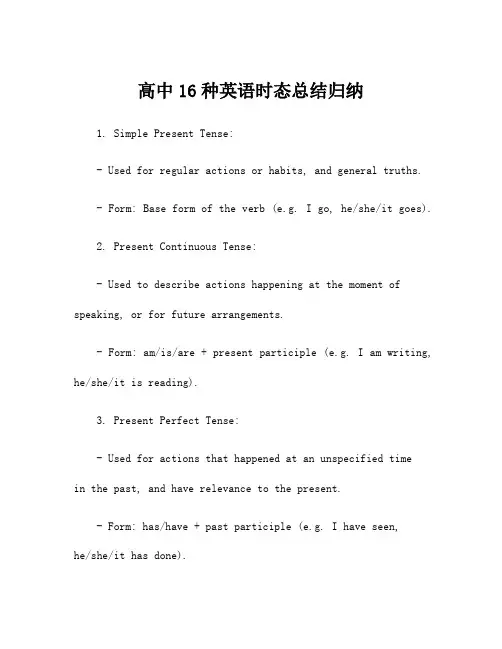
高中16种英语时态总结归纳1. Simple Present Tense:- Used for regular actions or habits, and general truths.- Form: Base form of the verb (e.g. I go, he/she/it goes).2. Present Continuous Tense:- Used to describe actions happening at the moment of speaking, or for future arrangements.- Form: am/is/are + present participle (e.g. I am writing, he/she/it is reading).3. Present Perfect Tense:- Used for actions that happened at an unspecified timein the past, and have relevance to the present.- Form: has/have + past participle (e.g. I have seen,he/she/it has done).4. Present Perfect Continuous Tense:- Used for actions that started in the past and continue into the present, and emphasize duration.- Form: has/have been + present participle (e.g. I have been waiting, he/she/it has been working).5. Simple Past Tense:- Used for actions that started and finished at aspecific time in the past.- Form: Past form of the verb (e.g. I went, he/she/it played).6. Past Continuous Tense:- Used to emphasize the duration of an action in the past, or for two actions happening simultaneously in the past.- Form: was/were + present participle (e.g. I was sleeping, he/she/it was writing).7. Past Perfect Tense:- Used to describe an action that happened before another action in the past.- Form: had + past participle (e.g. I had seen, he/she/it had finished).8. Past Perfect Continuous Tense:- Used to show the duration of an action that happened before another action in the past.- Form: had been + present participle (e.g. I had been waiting, he/she/it had been studying).9. Simple Future Tense:- Used to talk about actions that will happen in the future.- Form: will/shall + base form of the verb (e.g. I will go, he/she/it will eat).10. Future Continuous Tense:- Used to describe actions that will be ongoing at a specific time in the future.- Form: will/shall be + present participle (e.g. I will be waiting, he/she/it will be working).11. Future Perfect Tense:- Used for actions that will be completed before another action in the future.- Form: will have + past participle (e.g. I will have finished, he/she/it will have left).12. Future Perfect Continuous Tense:- Used to emphasize the duration of an action that will be completed before another action in the future.- Form: will have been + present participle (e.g. I will have been waiting, he/she/it will have been studying).13. Present Unreal Conditional:- Used to talk about hypothetical situations in the present or future, expressing results that are unlikely or impossible.- Form: if + simple past, would + base form (e.g. If I were rich, I would travel the world).14. Past Unreal Conditional:- Used to talk about hypothetical situations in the past, expressing results that didn't happen.- Form: if + past perfect, would have + past participle(e.g. If I had studied harder, I would have passed the test).15. Mixed Tenses:- Used to describe actions that happen at the same time but in the past and present or future.- Form: Mix of different tenses.16. Future Time Clauses:- Used to indicate two actions happening in the future, with the main clause in the future and the time clause in the present.- Form: Present tense in the time clause, will/shall or other future tense in main clause (e.g. When I am 25, I will have graduated).。
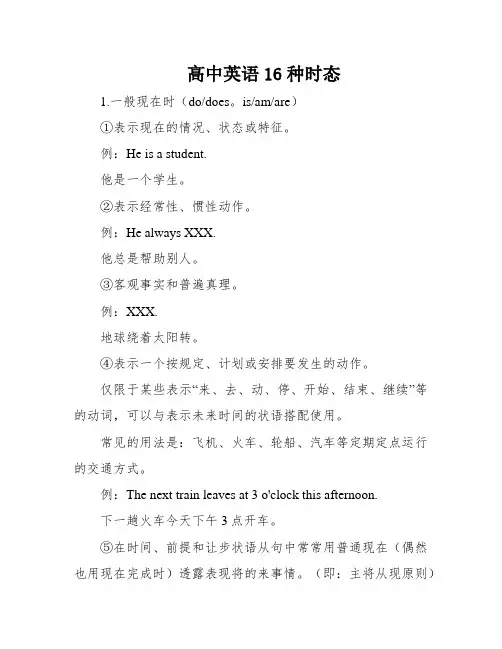
高中英语16种时态1.一般现在时(do/does。
is/am/are)①表示现在的情况、状态或特征。
例:He is a student.他是一个学生。
②表示经常性、惯性动作。
例:He always XXX.他总是帮助别人。
③客观事实和普遍真理。
例:XXX.地球绕着太阳转。
④表示一个按规定、计划或安排要发生的动作。
仅限于某些表示“来、去、动、停、开始、结束、继续”等的动词,可以与表示未来时间的状语搭配使用。
常见的用法是:飞机、火车、轮船、汽车等定期定点运行的交通方式。
例:The next train leaves at 3 o'clock this afternoon.下一趟火车今天下午3点开车。
⑤在时间、前提和让步状语从句中常常用普通现在(偶然也用现在完成时)透露表现将的来事情。
(即:主将从现原则)例:I will call you as soon as I arrive at the airport.我一到机场就会给你打德律风。
When you have finished the report。
I will have waited for about 3 hours.等你完成这份报告的时候,我就已经等了将近3个小时了。
2.现在进行时(am/is/are doing)①透露表现此时此刻正在发生的事情。
例:He is listning to the music now.他现在正在听音乐。
②表示目前一段时间内一直在做的事情,但不一定此时此刻正在做。
例:I am studying computer this term.这个学期我一直在进修计算机。
③现在进行时可以表示将来的含义。
a.瞬时动词的进行一定表未来。
例:I am leaving.我要离开了。
b.持续动词的进行只有有将来的时间状语或有将来语境中才表将来。
例:I am XXX XXX.下个月我要去旅行。
④现在进行时与频度副词连用,透露表现说话者或褒义或贬义的豪情色采。
高中16种英语时态总结归纳(推荐完整)编辑整理:尊敬的读者朋友们:这里是精品文档编辑中心,本文档内容是由我和我的同事精心编辑整理后发布的,发布之前我们对文中内容进行仔细校对,但是难免会有疏漏的地方,但是任然希望(高中16种英语时态总结归纳(推荐完整))的内容能够给您的工作和学习带来便利。
同时也真诚的希望收到您的建议和反馈,这将是我们进步的源泉,前进的动力。
本文可编辑可修改,如果觉得对您有帮助请收藏以便随时查阅,最后祝您生活愉快业绩进步,以下为高中16种英语时态总结归纳(推荐完整)的全部内容。
高中16种英语时态总结归纳(推荐完整)编辑整理:张嬗雒老师尊敬的读者朋友们:这里是精品文档编辑中心,本文档内容是由我和我的同事精心编辑整理后发布到文库,发布之前我们对文中内容进行仔细校对,但是难免会有疏漏的地方,但是我们任然希望高中16种英语时态总结归纳(推荐完整)这篇文档能够给您的工作和学习带来便利。
同时我们也真诚的希望收到您的建议和反馈到下面的留言区,这将是我们进步的源泉,前进的动力。
本文可编辑可修改,如果觉得对您有帮助请下载收藏以便随时查阅,最后祝您生活愉快业绩进步,以下为〈高中16种英语时态总结归纳(推荐完整)> 这篇文档的全部内容。
时态(Tense)是表示行为、动作和状态在各种时间条件下的动词形式.因此,当我们说时态结构的时候,指的是相应时态下的动词形式。
英语时态分为16种:一般现在、一般过去、一般将来、过去将来时,以及这四者的进行时、完成时和完成进行时。
1。
一般现在时用法:A)表示现在发生的动作、情况、状态和特征。
B)习惯用语。
C)经常性、习惯性动作。
例:He always helps others。
(他总是帮助别人。
)D) 客观事实和普遍真理。
尤其要注意,如果前后文不是一般现在时,则无法保持主句、从句时态一致。
E)表示一个按规定、计划或安排要发生的动作,(仅限于某些表示“来、去、动、停、开始、结束、继续”等的动词)可以与表示未来时间的状语搭配使用。
英语16时态电子图未来现在过去过去未来未来未来时态、时间现在过去将来过去将来一般时态do/does did will do Would do进行时态am/is/aredoing were/wasdoingwill be doing Would bedoing完成时态have/hasdone had done will have done Would havedone完成进行时态have beendoing had beendoingwill have beendoingWould havebeen doing二、常见时态标志词时态标志词一般现在时态every time每次in the morning早上once a week每周一次twice a month每月两次hardly ever几乎不every Sunday每个周日always总是usually通常often经常sometimes有时every day每天一般过去时ago以前yesterday昨天the day before yesterday前天last time上次last night昨晚last year去年last term上学期last Monday上周一once upon a time曾经(1)in+过去的时间过去某时in the early days在早期just now刚才一般将来时tomorrow明天the day after tomorrow后天next time下次next Friday下周五next month下个月next term下学期in+一段时间多久之后soon很快sooner or later迟早at once立刻by the end of+将来时间现在进行时look看listen听at this time此时at this moment此时at present现在right now现在过去进行时at that time在那时at that moment在那时将来进行时tomorrow,the day after tomorrow;soon;next week/month/year/...;the week/month/year现在完成时already已经yet还just刚才never从不ever曾经before以前up to now目前为止so far目前为止for+一段时间since+过去未来某一时间过去完成时by+过去时间点by the time到..时候为止by then到那时候by last time最后一次by the end of last week到了上周末before+过去时间点(3)up until+过去时间点up until then直到那时up until last time直到上次将来完成时the day after tomorrow;soon;next过去将来时the following month下个月the next time下次the next Friday 下周五the next term下学期三、被动语态主动语态被动语态一般时现在:do/does现在:be/is/are done过去:did过去:was/were done将来:will/shall do将来:will/shall be done 过去将来:would do过去将来:would be done进行时现在:am/is/are doing现在:am/is/are being done 过去:was/were doing过去:was/were being done完成时现在:have/has done现在:have/has been done过去:had done过去:had been done将来:will have done将来:will have been done过去将来:would have done过去将来:would have been done四、其他语法8类代词人称代词I、you、they、it(第一、第二、第三人称转换)物主代词my、his、their、mine、hers反身代词myself、ourselves、oneself相互代词each other、one another指示代词this、that、these、such、same疑问代词who、whom、whose、which、what关系代词who、whom、whose、which、that不定代词some、any、no、all、one、every、many、a little…8种句子结构主+谓He runs.他跑。
一、英语时态总结(一)现在时态(Tense)是表示行为、动作和状态在各种时间条件下的动词形式。
因此,当我们说时态结构的时候,指的是相应时态下的动词形式。
英语时态分为16 种:一般现在、一般过去、一般将来、过去将来时,以及这四者的进行时、完成时和完成进行时。
在这里,我们重点讲解一下最常见的11 种时态的用法和注意事项。
1. 一般现在时:A 表示现在发生的动作、情况、状态和特征。
eg: It is a nice day. 今天天气很好(表现在存在的状态)B 习惯用语:这个要在平时自己积累,因为习语太多,不做过多解释。
eg: Believe it or not we won the game. 我们赢得了比赛,信不信由你。
口语中常说believe it or not,意思是:“我说的是真的” “信不信由你” 。
believe itor not 是一个固定说法,相当一个插入语,短语中的believe 没有词形变化。
C 经常性、习惯性动作。
eg: He always helps others. (他总是帮助别人。
)D 客观事实和普遍真理。
尤其要注意,如果前后文不是一般现在时,则无法保持主句、从句时态一致.eg: He said that the sun rises in the east. 他说过太阳从东方升起这个句子要注意,前边虽然said 是过去式,但是后边“太阳从东方升起”是个客观真理,故不需同前边一样用过去式,而用一般现在时。
总而言之,记住:客观事实无论谓语的时态是什么都用一般现在时。
E 表示一个按规定、计划或安排要发生的动作,(仅限于某些表示“来、去、动、停、开始、结束、继续”等的动词)可以与表示未来时间的状语搭配使用。
常见的用法是:飞机、火车、轮船、汽车等定期定点运行的交通方式。
eg: When does the plane leave 飞机什么时候起飞eg: The plane leaves at 3 o’clock this afternoon. 飞机将在今下午三点起飞这个句子注意一下,飞机起飞本来是将来时,但为什么不用将来时,因为这里表示一个按规定、计划或安排要发生的动作,飞机起飞时间是规定、计划好了的。
高中英语16种时态表格英语时态分为16种:一般现在、一般过去、一般将来、过去将来时,以及这四者的进行时、完成时和完成进行时。
.1.一般现在时(do/does; is/am/are)① 表示现在的情况、状态或特征。
例:He is a student.他是一个学生。
② 表示经常性、习惯性动作。
例:He always helps others.他总是帮助别人。
③ 客观事实和普遍真理。
例:The earth moves the sun.地球绕着太阳转。
④ 表示一个按规定、计划或安排要发生的动作。
仅限于某些表示“来、去、动、停、开始、结束、继续”等的动词,可以与表示未来时间的状语搭配使用。
常见的用法是:飞机、火车、轮船、汽车等定期定点运行的交通方式。
例:The next train leaves at 3 o'clock this afternoon.下一趟火车今天下午3点开车。
⑤在时间、条件和让步状语从句中经常用一般现在(有时也用现在完成时)表示将来的事情。
(即:主将从现原则)例:I will call you as soon as I arrive at the airport.我一到机场就会给你打电话。
When you have finished the report, I will have waited for about 3 hours.等你完成这份报告的时候,我就已经等了将近3个小时了。
2. 现在进行时(am/is/are doing)①表示此时此刻正在发生的事情。
例:He is listning to the music now.他现在正在听音乐。
②表示目前一段时间内一直在做的事情,但不一定此时此刻正在做。
例:I am studying computer this term.这个学期我一直在学习计算机。
③现在进行时可以表示将来的含义。
瞬时动词的进行一定表将来。
例:I am leaving.我要离开了。
时态时态(Tense)是表⽰⾏为、动作和状态在各种时间条件下的动词形式。
因此,当我们说时态结构的时候,指的是相应时态下的动词形式。
1. ⼀般现在时⽤法:A) 表⽰现在发⽣的动作、情况、状态和特征。
B) 习惯⽤语。
C) 经常性、习惯性动作。
例:He always helps others. (他总是帮助别⼈。
)D) 客观事实和普遍真理。
E) 表⽰⼀个按规定、计划或安排要发⽣的动作,(仅限于某些表⽰“来、去、动、停、开始、结束、继续”等的动词)可以与表⽰未来时间的状语搭配使⽤。
常见的⽤法是:飞机、⽕车、轮船、汽车等定期定点运⾏的交通⽅式。
例:The next train leaves at 3 o'clock this afternoon.(下⼀趟⽕车今天下午3点开车。
)How often does this shuttle bus run? (这班车多久⼀趟?)2. 现在进⾏时(be doing)⽤法:现在正在进⾏的动作。
3. 现在完成时(have done)⽤法:A) 表⽰动作到现在为⽌已经完成或刚刚完成。
B)表⽰从过去某时刻开始,持续到现在的动作或情况,并且有可能会继续延续下去。
此时经常⽤延续性动词。
时间状语常⽤since加⼀个过去的时间点,或for加⼀段时间,或by加⼀个现在时间。
例:Great as Newton was, many of his ideas ___________ today and are being modified by the work of scientists of our time.A) are to challenge C) have been challengedB) may be challenged D) are challengingC) 表⽰发⽣在过去,但对现在仍有影响的动作或情况。
通常⽤点动词,如:arrive, begin, find, give, lose等。
例:John has broken his left leg.(约翰摔断了左腿。
)【注意事项】A)现在完成时是联系过去和现在的纽带。
现在完成时和过去时的区别在于:现在完成时强调动作的动态,或受动态的影响,是动态的结果,对现在有影响;过去时只表⽰过去的某个具体时间⾥发⽣的动作,与现在没有联系。
例:He worked in that hospital for 8 years.(他曾经在那家医院⼯作了8年。
这只是讲述⼀个过去的事实,他现在已经不在那家医院了。
)He has worked in that hospital for 8 years.(他已经在那家医院⾥⼯作了8年。
表⽰他从过去开始⼯作,⼀直⼯作到现在,现在仍在那家医院⼯作。
)B)因为含有for加⼀段时间或since加⼀个时间点这样的时间状语的完成时,有动态和延续性的特点,所以不能使⽤终端动词或瞬间动词。
例:My sister has been married for 5 years.(过去分词做表语表⽰状态,可以延续)My sister has married. Don't disturb her.(终端动词)C) 在"this is the first/ second/ third…… time that……"句型⾥要求⽤完成时。
例:This is the second time that the products of our company have been shown in the International Exhibition.(这是我公司产品第⼆次参加国际展览会。
)D) 句型"It is/ has been……since"所使⽤的两种时态都正确。
例:It is/ has been 10 years since I last saw him.(从我上次见到他以来已经10年了。
)E) 在"no sooner than"、"hardly/ scarcely ……when"、"prior to"等句型中,主句要求完成时。
例:I haven't met that professor prior to today.(以前我从未见过那位教授。
)4. 现在完成进⾏时(have been doing)⽤法:表⽰某⼀动作开始于过去某⼀时间,延续或重复地出现⾄今,或将继续延续⾄将来。
例:We have been working on this project for over a month now.(到⽬前为⽌,我们⼀直在处理那个项⽬,已经花了⼀个多⽉时间了。
)注意事项:与现在完成时相⽐,现在完成进⾏时更强调:在从过去到现在的时间⾥,动作或状态⼀直持续或⼀直反复出现。
例: It seems oil ___________ from this pipe for some time. We'll have to take the machine apart to put it right.A) had leaked B) is leakingC) leaked D) has been leaking5. ⼀般过去时⽤法:A) 表⽰过去某个时间发⽣的动作或情况。
B) 表⽰过去习惯性动作。
特别是由would/ used to do表达的句型,本⾝表⽰的就是过去时。
例:The old man would sit on a bench in the quiet park and look at others for hours without doing anything or talking to anybody.(⽼⼈过去常常坐在宁静的公园⾥的⼀条长椅上,看着其他的⼈,⼀坐就是数个⼩时,什么也不⼲,也不和任何⼈交谈。
)He used to visit his mother once a week.(他以前总是每周看望⼀次他的母亲。
)C) 有时可代替⼀般现在时,表达⼀种婉转、客⽓、礼貌、商量的语⽓。
例:I wanted to ask you if I could borrow your car?(我想向您借车⽤⼀⽤,可以吗?)Would you mind my sitting here?(您介意我坐在这⾥吗?)注意事项:A)注意时间状语的搭配。
⼀般过去时的时间状语应该是表⽰过去某个时间的词或词组,如:yesterday,last month, in 1999, two days ago等,绝对不可与recently, in the past 10 years, this month等连⽤,因为这样的时间状语都与现在有关系,应该⽤现在完成时或⼀般现在时。
B) used to do的否定形式和疑问形式很特别:你怎么写都正确。
以否定形式为例:used not to do, didn't used to do, didn't use to do都对。
Used to do经常与 be used to doing sth/ sth结构进⾏对⽐。
前者表⽰"过去常常或过去曾经",要求加动词原形;后者表⽰"习惯于",要求加名词或动名词。
6. 过去完成时(had done)⽤法:表⽰在过去的某个时间或动作以前已经发⽣的动作或已经存在的状态。
就是我们常说的:表⽰"过去的过去的动作或状态"。
Until then, his family _________ from him for six months.A) didn't hear C) hasn't heard B) hasn't been hearing D) hadn't heard全句的意思是:“到那时为⽌,他家⾥已经有六个⽉没得到他的消息了。
”注意事项:“过去的过去”这种逻辑关系常通过上下⽂体现出来,⽽不⼀定受某个时间状语的限制。
例:There had been some one in our room just now, because I noticed a burning cigarette end on the floor when we opened the front door.(刚才有⼈在我们的房间⾥,因为我们打开前门进来时,我注意到地板上有⼀⽀仍在燃烧的⾹烟。
)分析:虽然时间状语是just now,似乎应该使⽤⼀般过去时,但是“在房间⾥”这个状态是在"开门"和"注意"这两个过去的动作之前就存在的,所以应该⽤过去完成时。
7. 过去将来时(would/ should do)⽤法:表⽰从过去的某个时间看将要发⽣的事。
例:I said on Thursday I should see my friend the next day.(我星期四说我将于第⼆天拜访我的朋友。
)注意事项:由于过去将来时是由过去时和将来时组合⽽成的,所以其注意事项可以参考过去时和将来时的相关注意事项。
8. 过去进⾏时(was/ were doing)⽤法:A) 表⽰在过去⼀个⽐较具体的时间正在发⽣的动作。
例:Mary was listening to light music 10 minutes ago.(10分钟前,玛丽正在听轻⾳乐。
)B) 如果when, while这样的时间状语引导词所引导的主从句之⼀是⼀般过去时,则另⼀个句⼦常⽤过去进⾏时。
例:I was washing my hair when you knocked at the front door.(你敲前门时我正在洗头发。
)9. ⼀般将来时⽤法:A) 基本结构是will / shall do。
例:We shall send her a glass hand-made craft as her birthday gift.(我们将送给她⼀个玻璃的⼿⼯制品,作为给她的⽣⽇礼物。
)B) 有些动词,如:arrive, be close, come, do, done, go, have, leave, open, play, return, sleep, start, stay等,⽤于⼀般进⾏时,并且通常与⼀个表⽰将来时间的时间状语连⽤,可以表⽰将来时。
例:My mother is coming to visit me next week and is staying here until May.(我妈妈下周将来看我,并会呆到5⽉。
)C) 表⽰“打算去……,要……”时,可⽤be going to do。